Neighbouring Colombia and Peru, Ecuador is a relatively small country that nevertheless offers an enticing array of scenic landscapes, diverse wildlife species and interesting cities. Dense Amazon rainforest, towering Andean mountain peaks, palm-fringed Pacific Coast beaches and fascinating historical sites are all part and parcel of Ecuador’s prolific charms. The former Inca town of Cuenca is the nation’s third-largest city and a Unesco World Heritage Site. This alluring city, with its cobbled streets, beautiful architecture and photogenic plazas, boasts a huge variety of museums and art galleries. The vibrant capital city of Quito is also worth a visit. Arguably the most dazzling jewel in Ecuador’s crown is the Galapagos Archipelago in the Pacific, about 1000 kilometres west of the mainland. Their magnificent, pristine landscapes and prolific wildlife, which inspired Charles Darwin, have made this cluster of islands a world-famous travel destination.
Resting approximately 12 kilometres southeast of Santa Cruz, the relatively small island of Santa Fe is one of the oldest islands in the Galapagos archipelago with rock formations below the water’s surface dating back almost four million years. The island is best known for its endemic Barrington Land Iguana as well as its towering prickly pear cacti which have been known to reach remarkable heights of up to 20 feet. The magnificent Barrington Bay is the only visitor site on the island. There are two hiking trails that start here. One leads to a scenic viewpoint atop a cliff and the other wends through a forest of gigantic opuntia cacti. The beach is popular with sea lions and is an excellent spot from which to snorkel the radiant blue-green waters. You may even spot a Galapagos green turtle gracefully swimming by.



San Cristóbal is the easternmost island in the Galapagos archipelago as well as the most populated. Famous for its natural attractions, the island also boasts some wonderful shopping and dining opportunities as well as a local airport. Take a break from snorkeling and hiking to enjoy the best Ecuadorian cuisine, or admire some of the exquisite artwork and designs at local galleries and markets. Must-see attractions include the Galapaguera Tortoise Reserve; the Interpretation Center (which provides important background information on the Galapagos); and Puerto Grande, a protected cove on the north-western side of the island boasting a magnificent white sandy beach - ideal for a peaceful walk, swim or photography sesssion.



Floreana Island is located in the far southern portion of the Galapagos archipelago. As the first of the islands to support permanent human habitation, Floreana boasts a rich heritage complete with tales of buccaneers, pirates, whalers, convicts, and colonists. Visitors are invited to follow in the footsteps of whalers in the 1700s and drop a postcard into the famous "post office" barrel. At the island's northern tip is Punta Cormorant, with its two beaches, one of which forms a nesting site for Galapagos green turtles and is aptly named "Flour Beach" for its soft, powder-white sand. Between these two beaches lies a salt lagoon frequented by long-legged greater flamingoes and other shorebirds. Floreana's unique human history, fascinating geology, remarkable wildlife, and the little village of Puerto Velasco Ibarra, offering excellent lodging and food, make an ideal base for visitors looking to explore these unforgettable islands.



Resting in the western part of the Galapagos archipelago, Isabela Island is larger than all of the rest of the islands combined. Comprising six volcanoes, the island is about 120 km long and covers 4,585 square kilometres. Travellers who make the effort to this visit this remote location will be richly rewarded with a profusion of fascinating wildlife including large numbers of flamingos, typically spotted at the lagoon in town or along the boardwalk to the impressive Giant Tortoise Breeding Center. Don’t miss Concha de Perla, a natural pool which is ideal for snorkelling and interacting with sea lions; Las Tintoreras, a lagoon where white tip sharks come to rest; and Los Tuneles, where you'll find an abundance of turtles, rays, and fish swimming in the canals and pools.
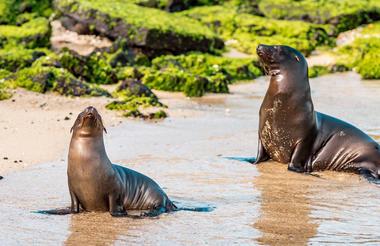
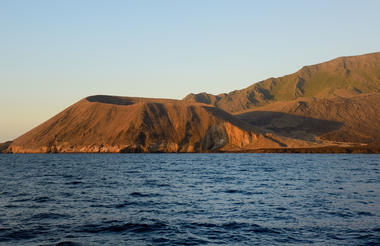
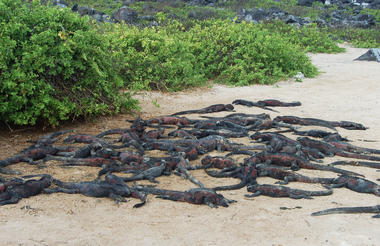
The island of Santa Cruz is home to Puerto Ayora, the largest and most developed town in the Galapagos. Although many travellers use it as a springboard to explore the more remote surrounding islands, those who venture deeper will find that Santa Cruz has much to offer in its own right. With numerous visitor sites, easily accessible beaches, and remote highlands at its heart, the island serves as an excellent base for adventure. Its most renowned attraction, the Charles Darwin Station, features an impressive turtle breeding programme and fascinating displays on the conservation of the Galapagos’ unique biosphere. Visitors can also swim or snorkel at the island’s magnificent beaches, where white sand and turquoise waters are alive with pelicans, blue-footed boobies, and marine iguanas.
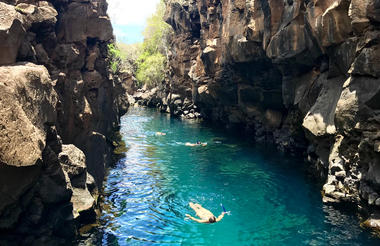
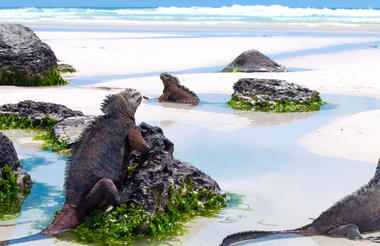
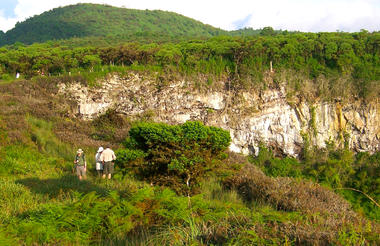
Perched at the southern edge of the Galápagos archipelago, Española Island, Ecuador, exudes a raw, untamed beauty. Its windswept cliffs, golden beaches, and rugged lava formations create a dramatic backdrop where wildlife reigns supreme. Visitors are captivated by the island’s most famous residents: seasonally, thousands of waved albatrosses perform intricate courtship dances, playful sea lions basking on sun-warmed rocks, and vibrant marine iguanas dotting the shores. Snorkelling in crystalline waters reveals a kaleidoscope of tropical fish, while the rhythmic crash of waves against cliffs underscores the island’s isolation. Accessible only via guided tours, Española offers a tranquil yet exhilarating encounter with nature, rewarding travellers with rare glimpses of one of the world’s most pristine and extraordinary ecosystems.








